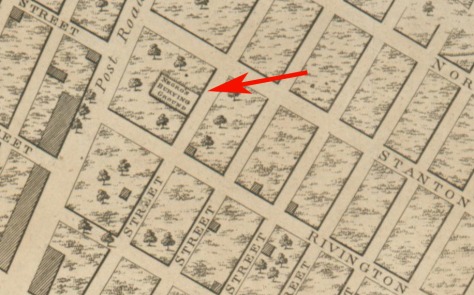In October 1767,
George Washington bought two “Mulatto”
boys named
Will and Frank and two “Negro” boys named Adam and Jack from Mary Lee, widow of Col. John Lee of Westmoreland County.
John Lee (1724-1767) had married the young widow Mary (Smith) Ball in 1749. They had no children together before he died. Given how the
enslaved mulatto boys were Col. Lee’s property and later took his surname, he’s the man most likely to have been their father. In any event, his widow sent them off with another master soon after the colonel’s death.
Mary went on to wed John Smith in August 1768, and Washington dined with that couple the day after their marriage. There were so many Smiths, Lees, and Balls in Virginia that I can’t tell if John or Mary Lee was related to
Washington’s mother’s Ball family or the Lee family his descendants married into, but they were in the same social circle.
Washington paid £61.15s for Will and Frank, more than three times the £19 he paid for the other two youths. All four slaves were probably teenaged males with many productive years before them, but the brothers’ lighter skin made them particularly valuable as domestic servants.
The Washington Papers include lists of “tithables” on his lands each June for many years. High among the “Ho[use]. Servants” on those lists from 1768 to 1771 was “Billy.” On 8 Oct 1770, Washington wrote in his diary about “my boy Billy who was taken sick.”
In September 1771, however, Washington recorded paying for a “pair of
Boots for Will.” The editors of the papers wrote that there were enslaved men named Will on different
farms, but those boots mostly likely went to the house servant he had bought in 1767, now close to manhood.
After that point, Washington stopped referring to the young man as “Billy,” at least in writing (except indirectly in connection with one incident I’ll discuss tomorrow). On the tithables lists “Will” appeared starting in 1772. His brother “Frank” had arrived on those list of house servants in 1771, along with “Herculas,” most likely
Hercules Posey.
When Washington rode off to war in 1775, he brought Will with him as a body servant. The young man, then probably in his twenties, was at the commander’s headquarters in
Cambridge, where on 22 Feb 1776 the steward recorded this expense in his: “Paid
Margaret Thomas for making three shirts for William.”
Ten years later, on 18 Feb 1786, Washington made a comprehensive list of his human property. At the top was “Will Val de Chambre,” followed by waiter “Frank” and soon after cook “Herculus.” In that decade Will suffered two falls that injured his knees badly so he was no longer able to wait on Washington as had trained to do. He became a shoemaker at Mount Vernon.
In his 1799
will, Washington granted freedom and a pension to “my Mulatto man William (calling himself William Lee)”—the first time he referred to his wartime companion with a surname.
In a memoir first extracted in the
American Turf Register and Sporting Magazine in 1829, Washington’s step-grandson,
George Washington Parke Custis, referred to “his huntsman, Will Lee.” But he also wrote that that servant “was better known in Revolutionary lore as Billy.”
Indeed, while Washington himself never wrote of his body servant as “Billy” after 1771, other people referred to him by that diminutive. For example, on 27 Apr 1789 Clement Biddle wrote to the new President from Philadelphia, “I have frequently called to see Billy.” William Lee continued to live at Mount Vernon until his death around 1824, and nineteenth-century articles and memoirs about visiting there, such as the one by
Elkanah Watson, called him “Billy.”
Nineteenth-century authors therefore developed a new way of referring to Washington’s body servant Will—as “Billy Lee,” a combination of names the general himself never used in writing. That’s become a standard reference. It shows up in, for instance, this month’s History Channel series about Washington, at least from some commentators.
But is that how historians should refer to the man, especially during the war years? We don’t know what Gen. Washington called him in conversation, but in writing it was always “William” or “Will.” We also know that William Lee kept the surname of his first owner (and father?) more than thirty years after coming to Mount Vernon.
“Billy” is of course a diminutive, and American slaveholders and racists used such nicknames to belittle black men. Yet we also use such names for friends; it’s possible that Washington’s valet was happy to answer to that name from people he knew well. It’s also conceivable that when Will Lee became
disabled, still only in his late thirties and enslaved, he was reduced to such a state of dependency that people started to infantilize him as “Billy” again.
All those are conjectural possibilities, however. We know from Washington’s will that in middle age his former valet was “calling himself William Lee,” and that’s the name I use.




